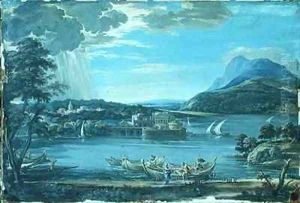Cortona, Pietro da Paintings
Pietro da Cortona, born Pietro Berrettini, was an Italian Baroque painter and architect who significantly contributed to the Roman and Tuscan art of his time. Born on November 1, 1596, in Cortona, Tuscany, he initially trained with his uncle Filippo Berrettini and, later, in Florence with Andrea Commodi. His early work was influenced by the Mannerist style, but he soon embraced the Baroque movement, which was gaining momentum throughout Europe.
Pietro da Cortona moved to Rome in 1612, and his career flourished under the patronage of Pope Urban VIII and the Barberini family. He became renowned for his fresco cycles, which combined dramatic composition, rich colors, and a masterful use of light and shadow. One of his most significant works is the ceiling fresco 'The Allegory of Divine Providence and Barberini Power' in the Palazzo Barberini's Gran Salone, completed in 1639. This masterpiece exemplifies his ability to create a sense of vast space and to incorporate architecture into his paintings in a way that was innovative for his time.
Cortona's architectural work is also noteworthy. He designed several Roman churches and palaces, including the church of Santi Luca e Martina and the façade of Santa Maria della Pace. His architectural style was characterized by grandiosity and a dynamic sense of movement, which complemented his decorative paintings. Pietro da Cortona's influence extended to his pupils and contemporaries, contributing to the spread of Baroque style throughout Italy and beyond.
He returned to Florence on several occasions, where he worked on various projects, including the design of the Pitti Palace facade and the frescoes in the Palazzo Pitti's Sala della Stufa. Pietro da Cortona's work in Florence helped establish the Baroque style in the city, which had been a stronghold of Renaissance art.
Pietro da Cortona died in Rome on May 16, 1669. His legacy lived on through his numerous pupils, including Ciro Ferri and Giovanni Francesco Romanelli, who continued to disseminate his style and techniques. Today, Pietro da Cortona is remembered as one of the leading figures of the Baroque movement, with his work remaining a testament to the era's grandeur and dynamism.

